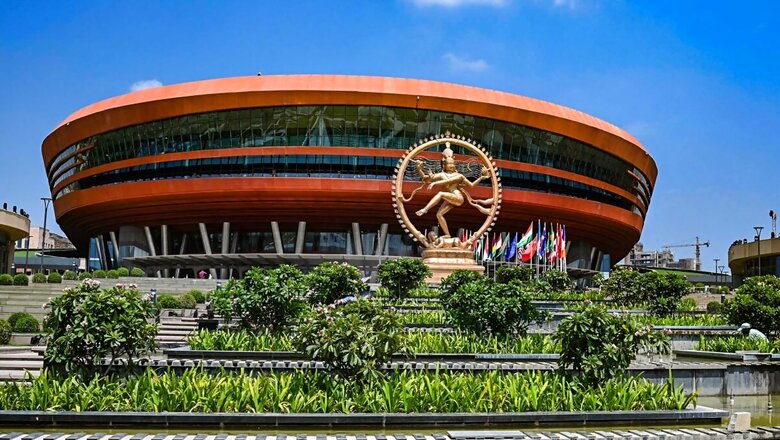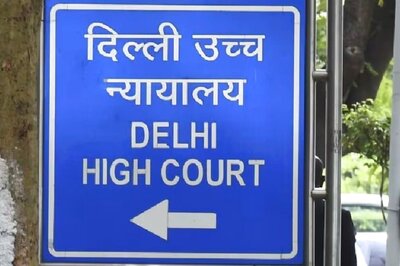
views
Graceful sandstone pillars, ornamental panels inspired by traditional ‘jaalis’, richly embroidered carpets and Rajasthani style friezes on the oval core of the ceiling — a piece of India resides inside the Bharat Mandapam where the G20 Summit was just hosted.
The newly built international convention and exhibition centre at Pragati Maidan is a state-of-the-art complex and presents a picture of modernity but art and traditions of the country are also reflected in its design and architecture.
The mandapam hosted the G20 Summit from September 9-10, but beyond limited visuals seen on television and the internet during the mega conclave, the internal features of the new landmark of Delhi remain a mystery for many as it is yet to be opened to the public.
The ‘Summit Meeting Room’ has modern air-conditioning, acoustic and seating facilities but the heritage of India has been tastefully incorporated into its design.
Beneath the oval core of the ceiling of the summit room’, are laid richly embroidery colourful carpets surrounding modern digital screen panels, and next to the round table area, a creamish-colour carpet bearing floral embellishments adorn the floor.
Sandstone, a common feature in old buildings of Delhi, from Shahjahanabad to the Raisina Hill complex, has been used in the pillars of the summit room, while ornamental panels inspired by traditional ‘jaalis’, present in Mughal-era buildings and monuments as well as in palaces in various parts of India, punctuate the walls of the cavernous room.
Behind each of these panels is another fabric-based panel adorned with motifs of traditional Indian embroidery style, adding to the elegance of the room.
Around the oval core of the ceiling, Rajasthani-style friezes seen in palaces and havelis have been painted.
Right next to it is the ‘Leaders’ Lounge’ where world leaders such as US President Joe Biden, UK Prime Minister Rishi Sunak and French President Emmanuel Macron, among others sat and relaxed in between meetings of the G20 Summit.
Potted Areca Palm plants and rich stocks of daises were added in the royal lounge just for the summit and millet-based snacks and Indian coffee, among other items, were on the menu for high tea arranged for them, said a source, who was part of the arrangements team.
Outside the ‘Summit Meeting Room’ and ‘Leaders’ Lounge’ a huge hallway is currently hosting the ‘Culture Corridor — G20 Digital Museum’ which was tailor-made just for the summit.
Huge wooden doors with leaf-style ornamental patterns on its outward side open into the hallway where rare and rich artefacts sourced from all G20 members nations and invited countries are currently displayed as part of the one-of-its-kind project.
“The world leaders experienced the hospitality and heritage of India as also its embrace of modernity and its technological prowess, particularly the growth of the digital public infrastructure of India,” G20 India Special Secretary Muktesh Pardesi told PTI.
Outside the two aesthetically appealing rooms, on the rich wooden panels facing the hallway are three giant canvases which celebrate the heritage of India with a contemporary touch.
According to a panel installed next to a canvas, the project is titled ‘Incredible India’ and draws from the style of miniature paintings of the country.
The central artworks depicts a “thriving city with a fort set in a beautiful landscape with angels of peace descending from the sky”.
The other two canvases portray the celebrations on the “arrival of monsoon winds that translate the land into a beautiful ecosystem”.
Many security personnel, other staff and some other authorised visitors were seen taking pictures inside the summit room, and also with the board ‘Bharat’ that was placed in front of India’s chair during the G20 Summit.
Several others took selfies with flags and G20 backdrop in the summit room or the welcome backdrop that was used on Saturday morning when Prime Minister Narendra Modi greeted various world leaders just before the summit got underway.
The welcome backdrop depicted the ancient Konark temple of Odisha with the G20 logo depicted on one side and the presidency’s theme ‘Vasudhaiva Kutumbakam’ — One Earth. One Family. One Future’ — on the other side.
A level above where President Droupadi Murmu and Prime Minister Modi had greeted them before the ceremonial dinner, the backdrop had depicted the ancient Nalanda university ruins in Bihar. Yoga has been celebrated in a relief on a wall near the entry gate which was used by world leaders to enter the Bharat Mandapam building on Saturday morning.
In the corridor next to it, a small statue of Nataraja is placed, while the 27-foot tall Nataraja made with ancient lost wax technique used for Chlola bronzes, stands majestically in the verdant lawns, adding an artistic and divine touch.

















Comments
0 comment